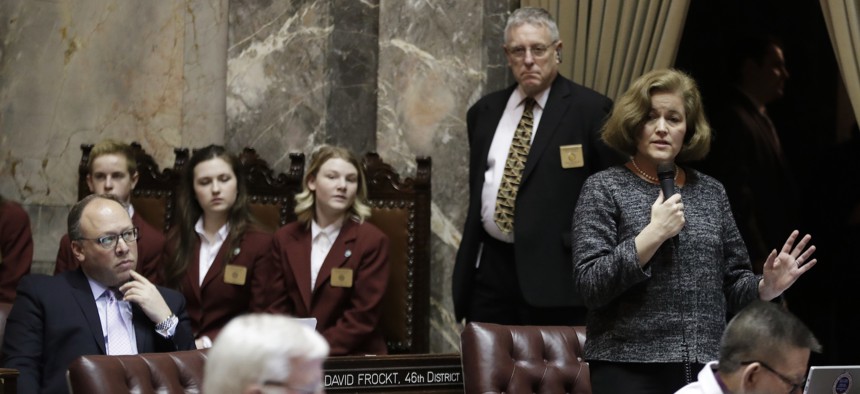State Legislatures—And Careers—Are Shaped by Gender Bias

Washington state Sen. Christine Rolfes, right, speaks on the Senate floor during debate over the supplemental budget, Thursday, March 8, 2018 at the Washington State Capitol in Olympia. Ted S. Warren / AP Photo
A new analysis of 25,000 careers in state legislatures suggests women are being pigeonholed into “women’s issues,” and passed over for key roles in favor of their male counterparts.
New research suggests women who become state legislators are potentially being kept out of plum roles due to institutional biases.
The report, titled “The Gender Gap in Political Careers: Evidence from U.S. State Legislatures,” found “consistent evidence that the gender gap in political careers reflects more than self-selection,” by studying the careers of 25,000 U.S. state legislators. Institutional roadblocks may be holding women back on career advancements like attaining leadership roles, key committee chairs and success in fundraising.
Not only does the study show that women hold committee chair positions and party leadership positions at a rate below their proportion (as of 2015, women made up just 25 percent of state legislatures), but they are also “less likely to serve on top-flight committees,” which are “defined to be the committees most valued by donors.”
In fact, female state legislators are 17 percent less likely to chair a top-flight committee, as well as 17 percent less likely to serve in party leadership.
The study, conducted by Alexander Fouirnaies of the University of Chicago, Andrew B. Hall of Stanford University and Julia Payson of New York University, attempted to account for constituency preferences, seniority and other factors to try to ensure there weren’t other biases beyond gender that were creating the causation. This only sharpened and clarified the gender-based differences.
This disparity may be having a serious impact on female legislators’ careers.
For instance, despite the fact that the researchers found “almost no discernible gender differences in legislative productivity,” the study found that women “face a fundraising penalty once in office,” being provided less money than their male counterparts by donors.
The researchers believe “the challenging landscape that women legislators face inside the legislature may help to explain the well-known fact that men are more likely to seek political office than women in the United States.”
Female Legislators Work on ‘Women’s Issues’—But Not Necessarily Out of Preference
Female legislators are more likely to serve on “women’s-issues committees”—defined as those dealing with education, health and welfare.
The analyses suggest that this is not a matter of preference. Rather, “institutional factors contribute substantially to the observed differences in men and women’s legislative careers.”
To put it more succinctly, the data appears to show that women are being pigeonholed into these positions.
According to quote the study, “most if not all of the overall difference in men and women’s focus on women’s issues can be explained by the higher rate at which women serve on women’s issues committees … we see no evidence that women exhibit a pre-existing interest in women’s issues legislation before they are assigned to women’s issues committees.”
There is some hope for change. Researchers found data suggesting “having at least one woman in leadership predicts that the underrepresentation of women in top-flight committees falls by 67 percent.” The study points out this correlates with a slew of studies that show women in management roles can reduce workplace gender bias.
The researchers did state that while the results “help to shed light” on these issues, “they do not explain precisely why these challenges exist.”
“Women may receive fewer opportunities to serve on top-flight committees and to serve in leadership because of explicit biases by senior men, or because of implicit biases, or because of self-censoring, or for any combination of these reasons or others,” the study concluded.
Mitch Herckis is the Senior Director of Programs for Government Executive’s Route Fifty and is based in Washington, D.C.
NEXT STORY: Texas School Districts Eye Oklahoma's Striking Teachers






